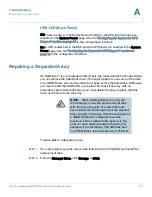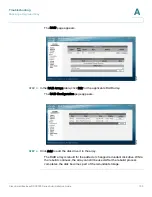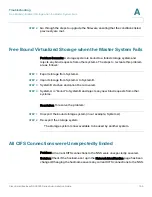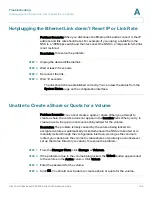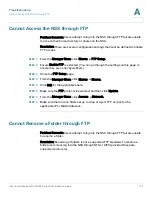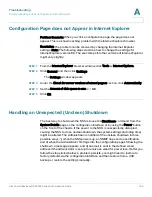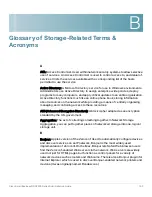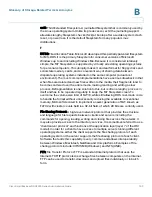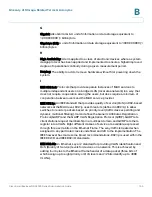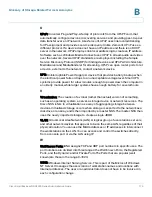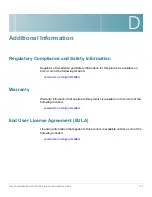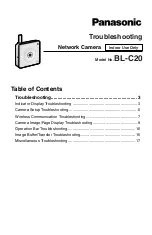
Glossary of Storage-Related Terms & Acronyms
Cisco Small Business NSS2000 Series Administration Guide
163
B
ext3: Third Extended Filesystem. A journalled filesystem that is commonly used by
the Linux operating system. Unlike its predecessor, ext2, the journaling support
alleviates lengthy filesystem checks (fsck) at bootup after a sudden system crash,
reset, or power loss. It is the default filesystem for many popular Linux
distributions.
F
FAT32: File Allocation Table. Microsoft developed this partially patented filesystem
for MS-DOS. It is the primary filesystem for consumer versions of Microsoft
Windows up to and including Windows Me. Because it is considered relatively
simple, the FAT filesystem is supported by virtually all existing operating systems
for personal computers. This ubiquity makes it an ideal format for floppy disks and
solid-state memory cards, and a convenient way of sharing data between
disparate operating systems installed on the same computer (a dual boot
environment). The most common implementations have a serious drawback in that
when files are deleted and new files written to the media, their fragments tend to
become scattered over the entire media, making reading and writing a slow
process. Defragmentation is one solution to this, but is often a lengthy process in
itself and has to be repeated regularly to keep the FAT filesystem clean. To
overcome the volume size limit of FAT16, while still allowing DOS real-mode code
to handle the format without unnecessarily reducing the available conventional
memory, Microsoft decided to implement a newer generation of FAT, known as
FAT32, with cluster counts held in a 32-bit field, of which 28 bits are currently used.
File Sharing Protocol: A high-level network protocol that provides the structure
and language for file requests between clients and servers, including the
commands for opening, reading, writing and closing files across the network. It
may also provide access to the directory services. It is sometimes referred to as a
"client/server protocol" and functions at the application layer (layer 7 of the OSI
model). In order for a client to have access to multiple servers running different
operating systems, either the client supports the file sharing protocol of each
operating system or the server supports the file sharing protocol of each client.
Software that adds this capability is very common and allows interoperability
between Windows, Macintosh, NetWare and Unix platforms. Examples of file
sharing protocols include: CIFS/SMB (Windows), and NFS (UNIX).
FTP: File Transfer Protocol. FTP is a standard Internet protocol that uses the
Internet’s TCP/IP protocols to exchange files between computers on the Internet.
FTP can be used to transfer, download, and upload files individually or in batch
form.



